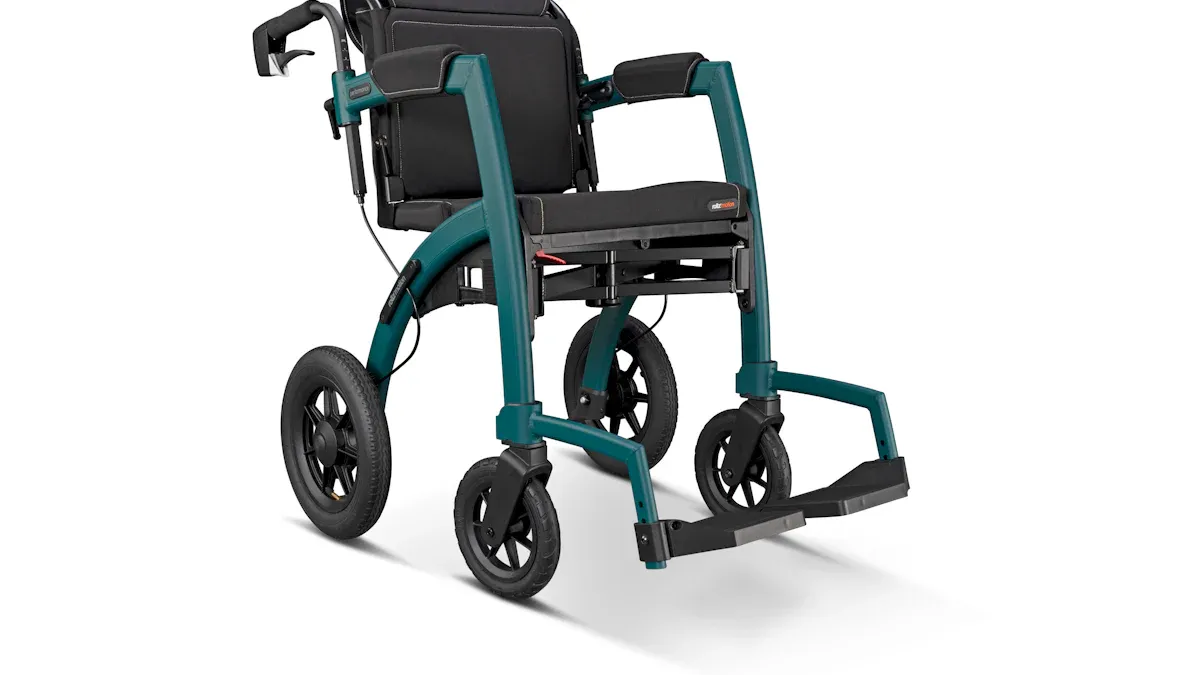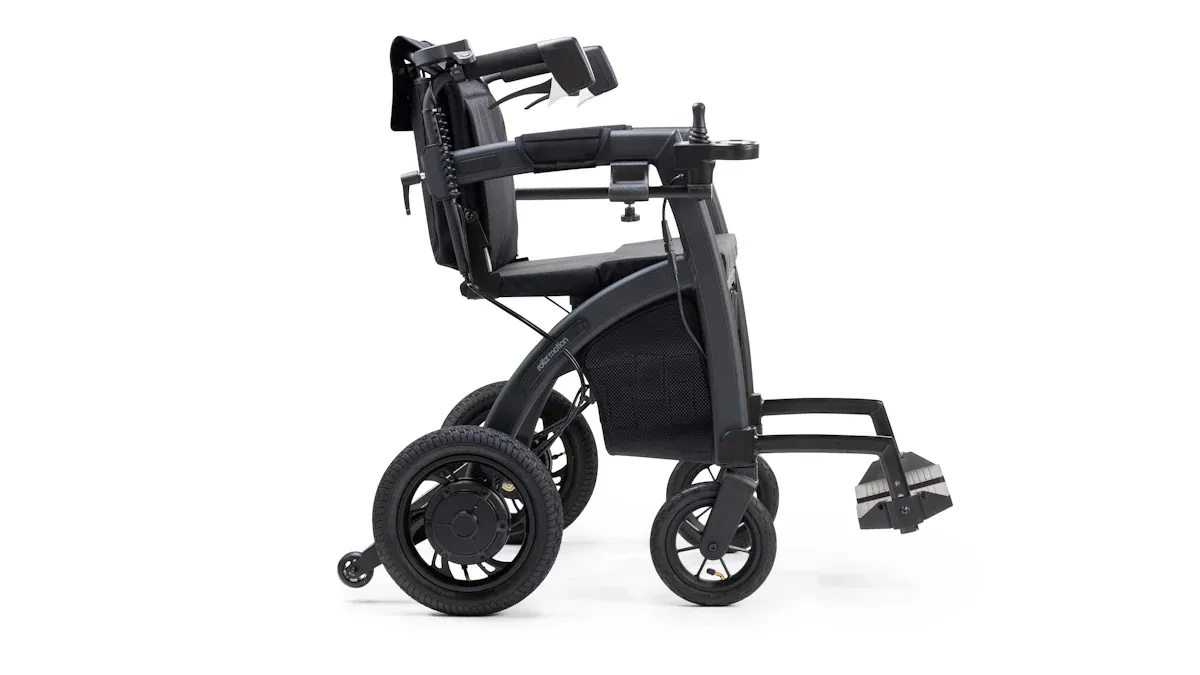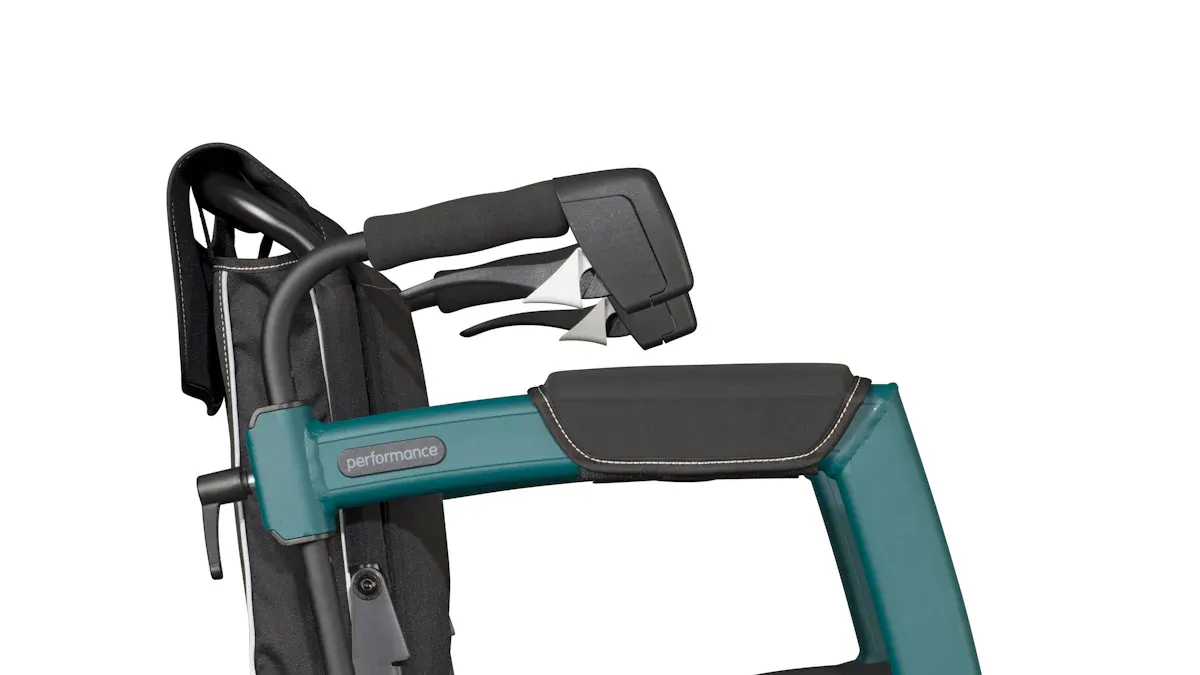
Imagine a world where mobility challenges no longer hinder independence. The Folding Disabled Power Wheelchair is turning that vision into reality. By merging portability with advanced technology, these devices are revolutionizing lives. The global market for power folding wheelchairs for disabled individuals is expected to grow from $1.2 billion in 2023 to $3.1 billion by 2032, fueled by innovations in mobility solutions and an aging population. Features like lightweight frames, foldable designs, and smart technology are enabling users to navigate their daily routines effortlessly. For many, an Electric Wheelchair For The Disabled is more than just a convenience—it’s a gateway to freedom.
Companies like Sunrise Medical are at the forefront with models such as the Quickie Q700 M Mini, which delivers portability without sacrificing functionality. These advancements underscore how innovation in 2025 will continue to redefine what a Wheelchair For The Disabled can accomplish.
Key Takeaways
- Folding power wheelchairs are portable and use smart technology. They help users move around easily and independently.
- Light materials and small designs make them simple to carry. Users can move through tight spaces without trouble.
- Smart features like AI and IoT turn them into clever tools. These tools make daily life easier for users.
- Safety features like obstacle sensors and auto brakes keep users safe. They give confidence when moving in different places.
- The future of these wheelchairs includes cool upgrades like self-charging. Biometric controls will also make them easier to use.
The Evolution of Folding Disabled Power Wheelchairs

Early Designs and Challenges
The journey of folding disabled power wheelchairs began with humble yet groundbreaking efforts. In 1932, Harry Jennings created the first folding wheelchair for his friend Herbert Everest, marking the birth of Everest & Jennings. This innovation introduced portability to wheelchair design, but early models faced significant challenges:
- Navigating rough terrain and steep ramps proved difficult.
- Users struggled with narrow doorways and small turning areas.
- Exposure to rain, snow, and extreme temperatures posed risks.
- Transporting goods or passengers on footrests and armrests raised safety concerns.
- Improper lifting techniques often led to injuries.
These obstacles highlighted the need for continuous improvement, setting the stage for future advancements.
Technological Milestones in Wheelchair Development
Over the decades, technology has transformed wheelchair design, accelerating innovation. Key milestones include:
- 1952: George Klein invented the electric wheelchair to assist wounded veterans, introducing powered mobility.
- Sensor technologies revolutionized wheelchair sports, enabling real-time performance analysis for athletes.
- Manual wheelchairs with advanced propulsion systems, like DC motors and ergonomic hand drives, improved usability for individuals with spinal cord injuries.
- Features like anti-rollback devices and two-speed mechanisms enhanced safety and comfort.
These advancements not only improved functionality but also expanded the possibilities for users seeking greater independence.
User-Centric Innovations Shaping the Market
Designers have increasingly prioritized user feedback to refine wheelchair features. By listening to users, they’ve uncovered pain points and opportunities for improvement.
Feedback fuels the iterative design process, driving continuous improvement.
Strategies like empathic design and prototype testing have empowered teams to create solutions tailored to real-world needs. For example, folding disabled power wheelchairs now incorporate lightweight frames, compact designs, and intuitive controls, making them more practical for daily use. This user-centric approach ensures that wheelchairs evolve alongside the needs of those who rely on them.
Key Features and Innovations in 2025

Lightweight and Compact Designs
In 2025, lightweight and compact designs are setting new standards for folding disabled power wheelchairs. Manufacturers are using advanced materials like aircraft-grade aluminum and carbon fiber to create ultra-lightweight models. These materials reduce the weight of wheelchairs to as little as 19 pounds while maintaining durability and strength. This makes them easier to carry, fold, and store.
One standout example is the Revolve Air wheelchair, which uses composite materials to fold into a size small enough to fit in standard cabin luggage. It takes up 60% less space when folded, making it ideal for frequent travelers. Quick-release rear wheels and improved locking mechanisms also enhance portability and energy efficiency. These innovations ensure that users can enjoy greater independence without compromising on performance.
Portability is a game-changer for users who need to transport their wheelchairs easily. Compact designs also reduce the time spent navigating tight spaces, making daily life more convenient.
Smart Technology Integration
Smart technology is transforming folding disabled power wheelchairs into intelligent mobility solutions. Many models now feature IoT and AI integration, enabling functionalities like autonomous navigation and health monitoring. These systems can connect with smart home devices, allowing users to control lights, thermostats, and even door locks directly from their wheelchairs.
Some advanced models use HITL-RL (Human-in-the-Loop Reinforcement Learning) technology. This system adapts to the user’s physiological responses and preferences, balancing comfort and activity levels. For example, if a user feels fatigued, the wheelchair can adjust its speed or suggest a rest period.
These innovations empower users to lead more active lifestyles. By integrating smart features, wheelchairs are no longer just mobility aids—they become personal assistants that enhance autonomy and quality of life.
Enhanced Battery and Charging Solutions
Battery technology has seen remarkable improvements, addressing one of the biggest challenges for wheelchair users: frequent charging. Modern batteries now offer longer life and greater energy efficiency, allowing users to travel longer distances without worrying about running out of power.
Advancements in charging systems have also reduced recharge times significantly. For instance, some models can achieve a full charge in just a few hours. This is especially beneficial for users who rely on their wheelchairs throughout the day.
| Feature | Improvement Description |
|---|---|
| Batteries with longer life | New technology has led to batteries that are more energy efficient and have greater storage capacity, allowing for longer travel distances without frequent charging. |
| Charging efficiency | Advancements in charging systems have reduced the time required for recharging batteries, enhancing user convenience. |
These enhancements make folding disabled power wheelchairs more reliable and user-friendly. With better battery performance, users can focus on their activities without interruptions.
Hands-Free and AI-Powered Navigation
Imagine navigating a crowded mall or a busy airport without lifting a finger. Hands-free and AI-powered navigation is making this possible for users of folding disabled power wheelchairs. These advanced systems combine artificial intelligence with intuitive controls to create a seamless mobility experience. By eliminating the need for manual operation, they empower users to focus on their surroundings rather than the mechanics of movement.
One of the most exciting developments in this space is the integration of gesture-based controls. For instance, the Intelligent Control Wheelchair uses visual hand gestures to guide movement. This innovation is especially helpful for individuals with severe upper limb impairments. Instead of struggling with traditional joysticks, users can simply wave or point to direct their wheelchair.
AI-powered navigation also excels in indoor environments. The Wheelesley system, for example, uses an onboard computer and sensors to map out efficient routes. Whether navigating tight hallways or avoiding obstacles, this robotic wheelchair system ensures smooth and safe travel.
| Case Study | Description |
|---|---|
| Wheelesley | A robotic wheelchair system that provides driving assistance and efficient indoor navigation through an onboard computer and sensors. |
| Intelligent Control Wheelchair | A joystick control system for users with severe upper extremity impairments, utilizing visual hand gestures for hands-free navigation. |
These technologies don’t just make life easier—they redefine independence. AI systems can even predict user needs. For example, some models learn daily routines and suggest optimized paths. Others use voice commands, allowing users to control their wheelchair with simple phrases like “move forward” or “turn left.”
Hands-free navigation isn’t just about convenience. It’s about giving users the freedom to explore their world with confidence.
As AI continues to evolve, the possibilities for folding disabled power wheelchairs are endless. From real-time obstacle detection to personalized navigation settings, these innovations are setting a new standard for mobility solutions.
Benefits of Folding Disabled Power Wheelchairs
Portability for Travel and Daily Use
Portability is one of the standout features of folding disabled power wheelchairs. These devices are designed to make life easier, whether users are traveling across the globe or simply navigating their daily routines. Lightweight materials, such as aluminum and carbon fiber, allow these wheelchairs to weigh less than 30 pounds. This makes them easy to fold, carry, and store in tight spaces like car trunks or airplane overhead compartments.
| Evidence | Description |
|---|---|
| Weight | Ultra-lightweight folding wheelchairs typically weigh less than 30 pounds. |
| Maneuverability | They enhance maneuverability and independence for users. |
| Portability | Many models are easy to fold and store, making them great for travelers. |
| User Empowerment | Users can load and unload them by themselves, which is empowering. |
| Energy Conservation | Mobility chairs help with disabilities, saving energy for tasks like cooking or cleaning. |
For frequent travelers, this portability is a game-changer. Imagine being able to fold your wheelchair in seconds and carry it onto a train or plane without assistance. This level of convenience empowers users to explore new places and engage in activities they might have avoided before. Even in daily life, the compact design helps users navigate tight spaces, like crowded restaurants or small elevators, with ease.
Folding disabled power wheelchairs aren’t just tools for mobility—they’re enablers of freedom and adventure.
Enhanced Safety Features
Safety is a top priority for wheelchair users, and modern designs have made significant strides in this area. Features like anti-tip wheels, automatic braking systems, and obstacle detection sensors reduce the risk of accidents. These advancements provide peace of mind, especially in busy or unfamiliar environments.
Research confirms that enhanced safety features lead to fewer mobility-related incidents. For example, driver monitoring systems and advanced driver-assistance systems (ADAS) have shown remarkable results in reducing distractions and aggressive movements.
| Evidence Type | Findings | Impact on Safety |
|---|---|---|
| Naturalistic Driving Data | 22 months of data from 373 light commercial vehicles | Warning-based ADAS reduces distraction events over time |
| Driver Monitoring Systems | Coaching & rewards reduce aggressive driving | Harsh acceleration reduced by 76%, harsh braking by 65% |
| Contextual Analysis | Identifies factors increasing distraction | Low-speed urban roads increase likelihood of warnings |
These technologies, when adapted for wheelchairs, create a safer experience for users. For instance, obstacle detection systems can alert users to potential hazards, while automatic brakes prevent unintended movements on slopes. Such features not only protect users but also boost their confidence in navigating different terrains.
Safety features in folding disabled power wheelchairs are more than just add-ons—they’re lifelines that ensure users can move with confidence and security.
Greater Independence and Autonomy
Folding disabled power wheelchairs are transforming lives by fostering greater independence. Improved designs and advanced features allow users to perform daily tasks without relying on others. For many, this means regaining control over their routines and enjoying a higher quality of life.
Studies highlight the impact of better wheelchair designs on user independence:
- 61% of older adults reported difficulty with manual wheelchair propulsion, indicating a need for better designs.
- Participants using individualized manual wheelchairs experienced less difficulty in propulsion and improved postural stability.
- Increased satisfaction with wheelchair technology was reported, leading to enhanced social function and quality of life.
Additionally, power-assist add-ons and individualized designs have proven to enhance mobility while reducing physical strain.
| Findings | Description |
|---|---|
| Power-Assist Add-Ons | Enhance user independence by improving mobility and reducing physical strain. |
| Individualized Manual Wheelchairs | Lead to better postural stability and increased satisfaction among users. |
| Quality of Life | Improved wheelchair designs contribute to a higher quality of life for older adults. |
These innovations empower users to take charge of their lives. Whether it’s running errands, attending social events, or simply moving around the house, folding disabled power wheelchairs make it all possible. They’re not just mobility aids—they’re tools for reclaiming independence.
Independence isn’t just about moving freely; it’s about living fully. Folding disabled power wheelchairs help users do exactly that.
Improved Quality of Life
A folding disabled power wheelchair does more than just provide mobility—it transforms lives. For many users, it opens the door to a better quality of life by addressing physical, emotional, and social needs. These wheelchairs empower individuals to regain control over their daily routines, fostering a sense of independence and self-worth.
Studies show that powered wheelchairs significantly improve various aspects of life for users. For instance, individuals with conditions like stroke report a positive impact on their overall well-being. Frequent use of these wheelchairs correlates with higher scores in competence and psychosocial health. This means users feel more capable and confident in their abilities, which directly enhances their happiness and self-esteem.
| Quality of Life Dimension | Improvement Observed |
|---|---|
| Competence | Yes |
| Independence | Yes |
| Capability | Yes |
| Well-being | Yes |
| Happiness | Yes |
| Self-esteem | Yes |
| Usual Activity | Significant Improvement |
These improvements don’t just happen by chance. Modern designs focus on user comfort and functionality, ensuring that wheelchairs meet the unique needs of each individual. Features like lightweight frames, intuitive controls, and smart technology make it easier for users to engage in their usual activities. Whether it’s attending a family gathering or running errands, these wheelchairs help users participate in life more fully.
It’s not just about mobility—it’s about living with dignity and joy.
However, the benefits go beyond physical independence. Users often experience reduced stress levels and a greater sense of well-being. This is especially true when service providers tailor wheelchair features to the specific needs of individuals. By addressing pain points and offering personalized solutions, these devices become more than just tools—they become life-enhancing companions.
The journey toward a better quality of life starts with the right mobility solution. A folding disabled power wheelchair offers the freedom to move, the confidence to explore, and the ability to live life on one’s own terms.
Market Trends and Future Outlook
Rising Demand for Smart, Foldable Designs
The demand for smart, foldable wheelchair designs is skyrocketing. Consumers are increasingly drawn to innovative mobility solutions that combine convenience with advanced technology. The intelligent electric wheelchair market is projected to grow at a compound annual growth rate (CAGR) exceeding X% from 2025 to 2033. This surge stems from the aging population and the rising prevalence of mobility impairments. Features like GPS tracking, fall detection, and app-enabled controls are becoming standard, appealing to tech-savvy users who value customization and ease of use.
Urbanization and improved healthcare infrastructure in emerging economies are also fueling this trend. Investments in rehabilitation centers and old-age homes are creating opportunities for manufacturers to introduce foldable models that cater to diverse needs. These designs offer portability and maneuverability, making them ideal for users navigating crowded urban environments. As technology continues to evolve, the Folding Disabled Power Wheelchair is becoming a symbol of independence and innovation.
Regional Market Growth and Trends
Regional markets are showing distinct growth patterns in the adoption of advanced wheelchair technologies. Europe leads the way, with over 45% of users receiving financial aid for powered wheelchairs. Countries like Germany, France, and the UK dominate demand due to strong healthcare systems and supportive policies.
Asia-Pacific represents over 25% of the global market, driven by increasing healthcare expenditure and an aging population. Pediatric wheelchair demand is rising in this region, contributing nearly 14% of total sales. However, affordability remains a challenge, with over 33% of users relying on manual wheelchairs.
North America faces unique hurdles. High costs limit accessibility, with only 40% of eligible patients utilizing powered wheelchairs. Wait times for subsidized models have increased by 15% annually over the past three years. Meanwhile, the Middle East & Africa hold around 10% of the market, where public health funding and awareness are steadily improving.
| Region | Key Insights |
|---|---|
| Europe | Over 45% of users receive financial aid; countries like Germany, France, and the UK dominate demand. |
| Asia-Pacific | Represents over 25% of the global market; increasing healthcare expenditure and aging population. |
| Middle East & Africa | Holds around 10% of the market; public health funding and awareness are increasing. |
| North America | High costs hinder growth; only 40% of eligible patients utilize powered wheelchairs due to affordability issues. |
Government Policies and Funding Support
Government initiatives play a crucial role in advancing wheelchair technology. Policies focus on refining public programs, creating incentives for alternative financing mechanisms, and expanding healthcare systems. Tax incentives for improved technology access and mandates for universal design are encouraging manufacturers to innovate.
Public-private partnerships are also gaining traction. These collaborations aim to make assistive technologies more affordable and accessible. For example, governments are capitalizing on advancements in telecommunications to change public policy and promote accessibility. By refining the nexus of civil rights and technology access, policymakers are ensuring that individuals with disabilities can benefit from cutting-edge solutions.
| Approach | Description |
|---|---|
| Refining, refocusing, and expanding public programs | Governments are improving existing programs to better serve individuals with disabilities. |
| Creating incentives for alternative financing mechanisms | Public-private partnerships are making wheelchair technologies more affordable. |
| Refining and refocusing the healthcare system | Both public and private insurance systems are being updated to cover advanced wheelchair designs. |
| Creating tax incentives | Tax breaks are encouraging manufacturers to develop innovative solutions. |
| Mandating universal design | Policies require wheelchair designs to be accessible to a wider range of users. |
| Capitalizing on telecommunications innovations | Governments are leveraging technology to improve accessibility and public policy. |
These efforts are paving the way for a future where assistive technologies like folding disabled power wheelchairs are accessible to all, regardless of financial or physical barriers.
Predictions for Future Innovations
The future of folding disabled power wheelchairs looks incredibly promising. As technology continues to evolve, these devices are expected to become even smarter, lighter, and more user-friendly. Here’s a glimpse into what might be on the horizon:
- Self-Charging Systems: Imagine a wheelchair that charges itself while in use. Researchers are exploring kinetic energy recovery systems, similar to those in electric cars, to make this a reality. This could eliminate the need for frequent charging and extend battery life significantly.
- Advanced AI Personalization: Future models may use artificial intelligence to learn a user’s habits and preferences. For instance, a wheelchair could automatically adjust its speed or seating position based on the user’s daily routine.
- Augmented Reality (AR) Integration: AR could assist users in navigating unfamiliar spaces. By projecting directions or alerts onto a small screen, users could move through crowded areas with ease.
- Biometric Controls: Wheelchairs might soon respond to voice commands, eye movements, or even brain signals. This would provide a game-changing solution for individuals with severe mobility impairments.
Tip: These innovations aren’t just about convenience—they’re about creating a world where mobility challenges no longer limit possibilities.
Another exciting area is sustainability. Manufacturers are experimenting with eco-friendly materials like recycled plastics and biodegradable composites. These efforts aim to reduce the environmental impact of wheelchair production while maintaining durability.
The future also holds promise for affordability. With advancements in 3D printing, custom wheelchairs could become more accessible. This technology allows for faster production and lower costs, making high-quality designs available to a broader audience.
The possibilities are endless. From self-driving capabilities to health-monitoring features, folding disabled power wheelchairs are set to redefine independence and mobility in ways we can only begin to imagine.
The advancements in folding disabled power wheelchairs are nothing short of revolutionary. From lightweight designs to AI-powered navigation, these innovations are reshaping how individuals with mobility challenges experience the world. In 2025, the global power assist wheelchair market is projected to reach $1238.3 million, with a CAGR of 4.7%. Meanwhile, the lightweight electric folding wheelchair market is expected to grow by 11.5%, reflecting the rising demand for smarter, more accessible solutions.

These technologies are more than just tools—they’re lifelines that empower users to reclaim their independence. With features like self-charging systems and biometric controls on the horizon, the future of mobility looks brighter than ever. The folding disabled power wheelchair is not just a product; it’s a symbol of freedom, innovation, and hope for a more inclusive world.
The journey ahead is exciting, filled with possibilities that promise to redefine mobility and independence for millions.
FAQ
What makes folding disabled power wheelchairs different from traditional models?
Folding power wheelchairs are lightweight and compact. They fold easily for storage or travel, unlike traditional models. These designs prioritize portability without sacrificing functionality, making them ideal for users who need mobility solutions on the go.
How long does the battery last on modern folding power wheelchairs?
Battery life varies by model, but most modern folding power wheelchairs offer a range of 10–20 miles on a single charge. Advanced batteries in 2025 provide longer life and faster charging, ensuring users can travel farther with fewer interruptions.
Are folding power wheelchairs suitable for outdoor use?
Yes, many folding power wheelchairs are designed for both indoor and outdoor use. Features like durable tires, anti-tip wheels, and obstacle detection systems make them reliable on various terrains, including sidewalks, parks, and uneven surfaces.
Can folding power wheelchairs be customized for individual needs?
Absolutely! Manufacturers offer customization options like adjustable seating, joystick placement, and smart technology integration. These features ensure the wheelchair meets the user’s specific comfort and mobility requirements, enhancing their overall experience.
How do I maintain a folding disabled power wheelchair?
Regular maintenance includes cleaning the frame, checking tire pressure, and ensuring the battery charges properly. Users should also inspect for loose parts and schedule professional servicing annually to keep the wheelchair in top condition.
Tip: Always refer to the manufacturer’s manual for specific maintenance guidelines.
Post time: Jun-10-2025
